October 25, 1924 Going East Again - To New York City and the Polo Grounds
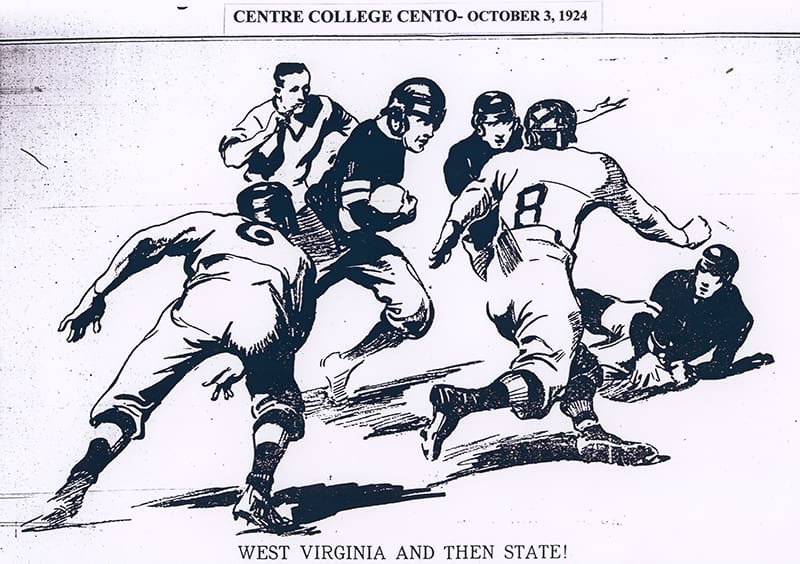
Cartoon produced and published in "Cento." The reference to "State" was regarding the game with Kentucky the week after the West Virginia game.
I was manager of the freshman team in 1924. Red Roberts came back on campus to coach the Lieutenants and as soon as he got in Danville, he looked me up and said he wanted his "son" to help with the first year team. Of course, I jumped at the chance.
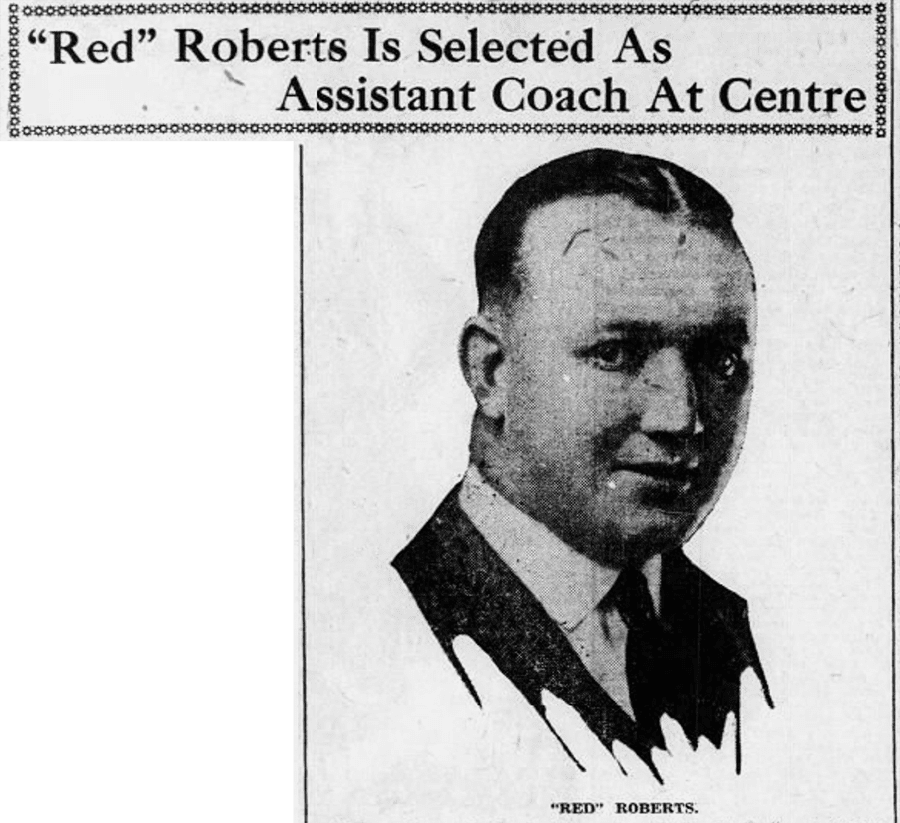
Red Robertson's "dad" takes over the assistant coaching position
There is a photograph that I have- a picture of the freshman team- and on the back row sit Red and me. His head looks about twice the size of mine. That's probably because it was.

The two Reds, Red Roberts and his "son," Red Robertson with the tie, on the back row. The bear, "Neversweat," apparently was kept as a mascot and cared for by Dudley Doneghy, trainer from 1919-1955, front.
Red managed to get me included on the trip to New York when we played West Virginia. He told the Chief that he felt it was only proper that as freshman manager, I should go because of how hard I had worked so far during the season. I wasn't so certain that I'd worked that hard but Chief Myers always seemed to like me, so he agreed with Red and I was included on the school's travel group. Red always made certain that he looked out for his "son."

Clipping in Robertson family scrapbook
For the fifth straight year, the Centre College football team was heading to the East, this time to New York City to play the West Virginia Mountaineers.
When the plans were announced, Centre's fans couldn't help but be proud of how far the little school had gone since it last met West Virginia, 5 years before.
In 1919, the team had taken a train over to Charleston, West Virginia, slept in a coach and not a Pullman sleeper on the way, and after playing an afternoon game, returned back home after the conclusion of what had been the breakthrough victory, 14-6, which sent Centre on its road to national fame.
Now the team was able to travel in a first class manner. The Colonels always had a specially chartered Pullman and stayed in the best facilities in whatever city they visited.
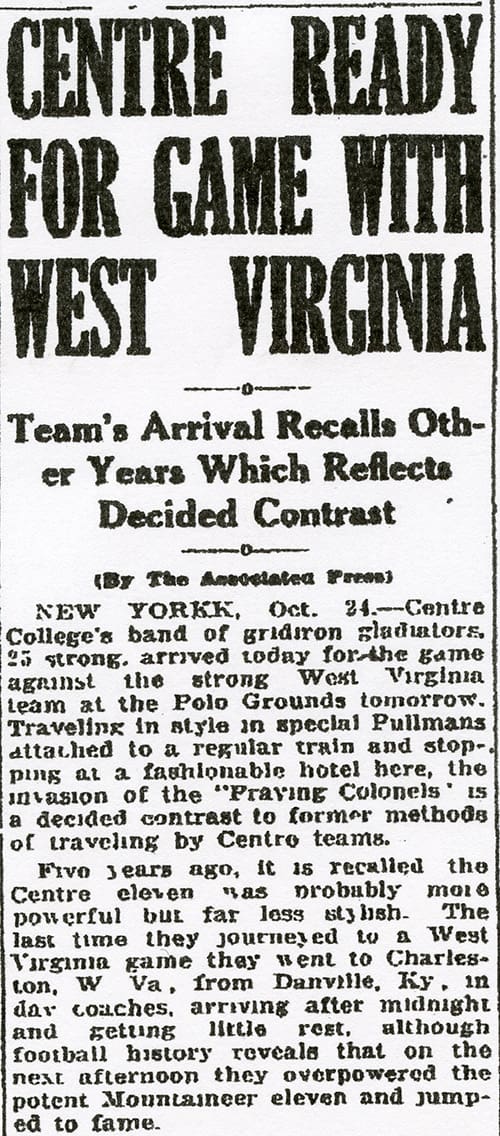
Traveling now in "special Pullmans" and stopping "at a fashionable hotel"
The story above about Centre traveling to the 1919 West Virginia game in day coaches and "getting little rest" was factual. The team actually slept in the coach on a side track which was part of the Charleston C&O station after first riding from Danville on the Southern Railroad to Lexington and then being hooked onto an eastern, Lexington to Charleston C&O regularly scheduled train.
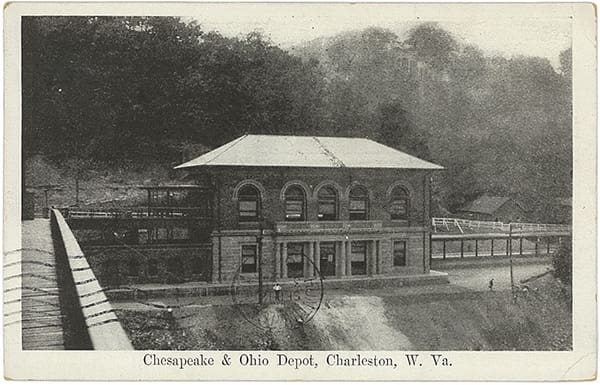
From sleeping in a passenger car along the depot at Charleston during the first game with West Virginia in 1919 to the Waldorf-Astoria in 1924!
It was to be different on this 5th trip to the East. The place chosen for the team was the wonderful Waldorf-Astoria Hotel, a combination of two luxury hotels built by William Waldorf Astor and his cousin, John Jacob Astor IV.
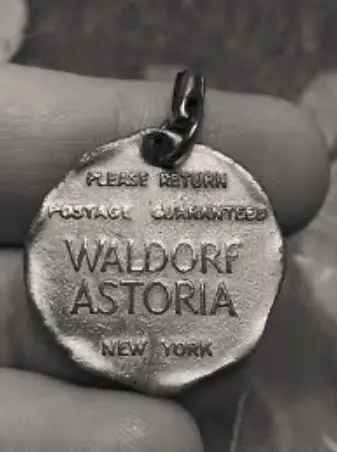
Hotel where the Colonels stayed
The 13 story Waldorf, built in 1893, and the 17 story Astoria, constructed 4 years later, were joined by a corridor when they were merged.
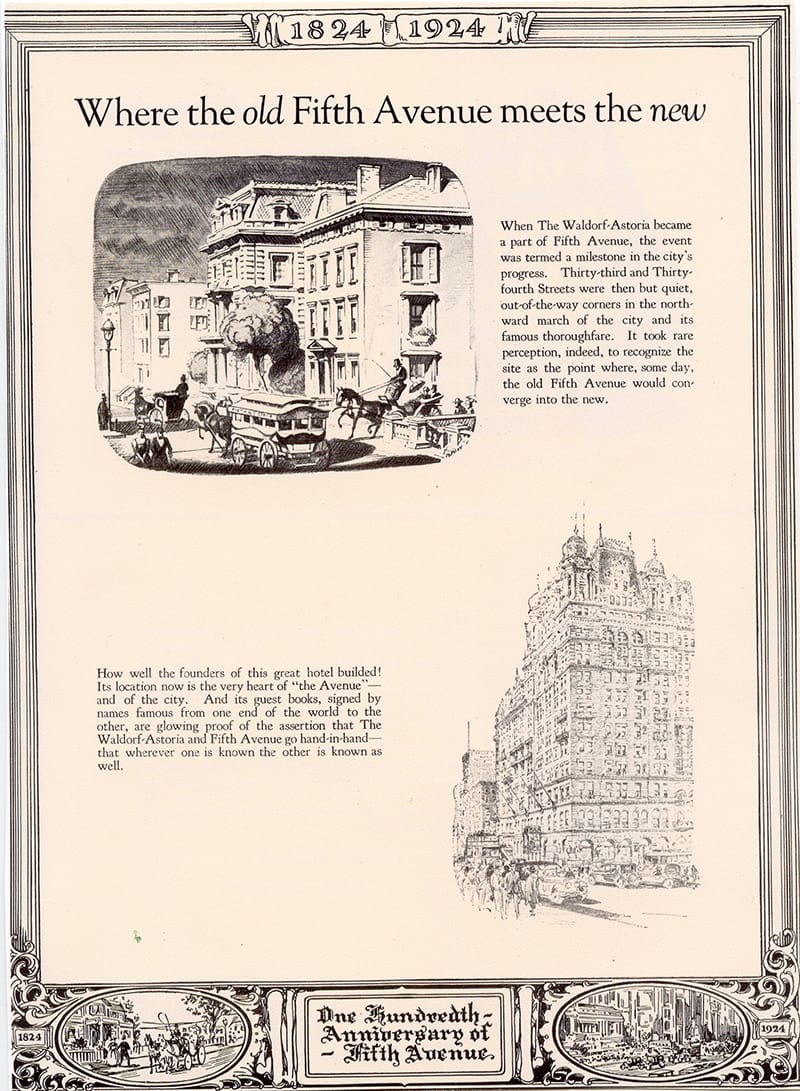
Besides the Colonels' Pullman, two additional sleepers were chartered to take Centre's supporters to the game. The trip was to begin at 7:25 in the morning on Thursday, October 23. The Pullmans would be connected to the Southern Railroad's regularly scheduled "Carolina Special," go through Lexington where some additional fans would board, and arrive in Cincinnati at 11:00 A.M. There would be a layover of slightly over 2 hours before the Pullmans would leave Cincinnati connected to the New York Central's "Ohio State Limited" and then it would hook onto the "Twentieth-Century Limited" at Cleveland and head east.
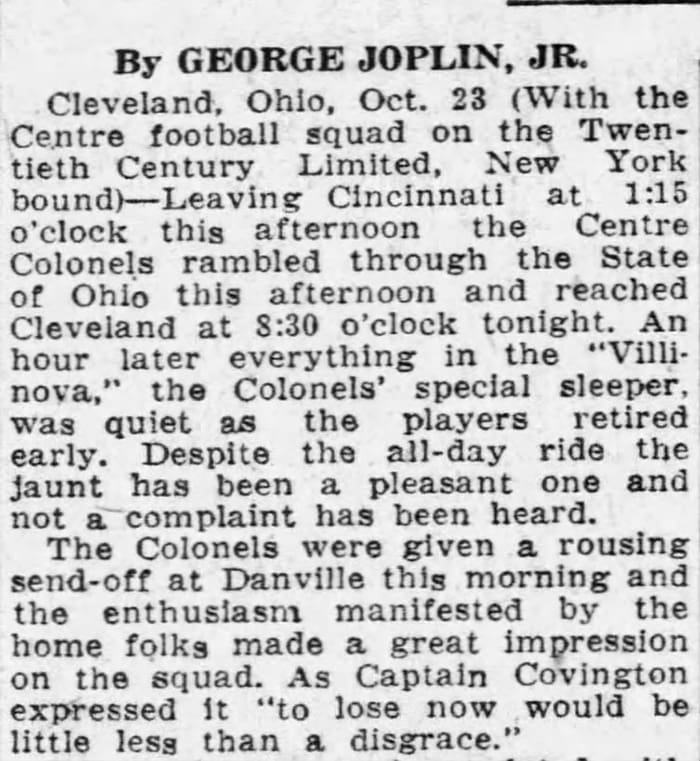
Another "rousing send-off"
The route to New York City was exactly the same as that taken during the three trips to Boston until the train reached Albany. It was northeast through Columbus, Ohio to Cleveland on the "Big Four's" tracks, and then due east along the south shore of Lake Erie to Buffalo. From Buffalo, the 4-track NYC line continued east to Albany. When the team had gone to Boston to play Harvard, its Pullman was transferred at Albany to a Boston and Albany Railroad train for the trip across Massachusetts.
There was no reconnection in Albany this time, as the Colonels' train continued south from Albany on the double-tracked last leg, directly into New York, with the "Twentieth Century Limited" arriving at the grand Beaux-Arts, Grand Central Terminal in New York at 9:40 A.M. on Friday, approximately 26 hours after leaving Danville.
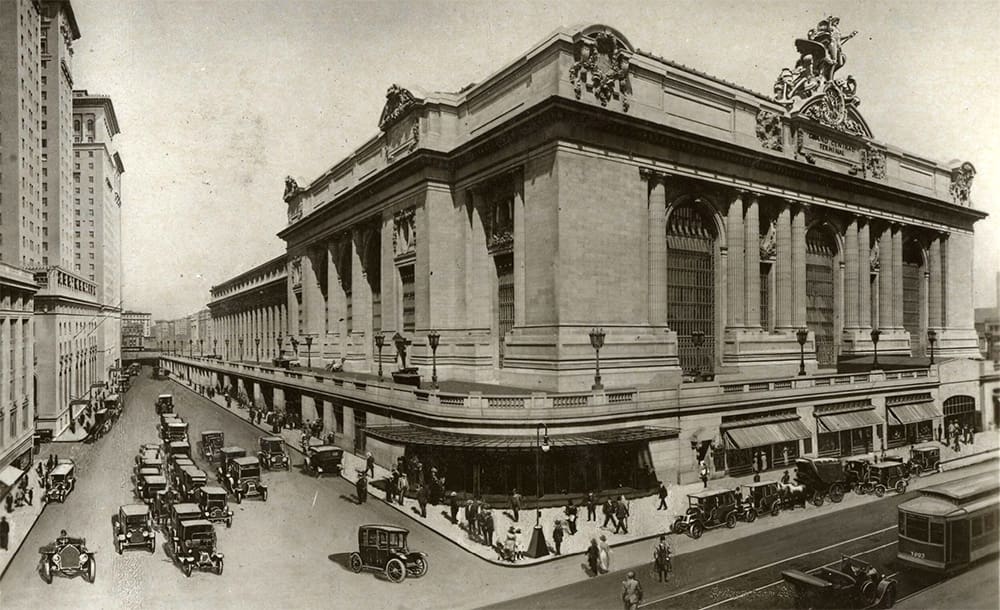
Grand Central Terminal, opened in 1913
The roundtrip fare was $81.00 for a lower birth and $78.00 for an upper. A two person drawing room could be had for $95.00 each, and a three-person cabin for $85.00 per passenger. Once arriving in New York, the travelers would be responsible for their own lodging at a hotel on Friday night, but could board Saturday evening at 10:00 P.M. after the game and dinner and a possible show and sleep in their Pullman. The train would then pull out of New York at 8:45 A.M. Sunday.
New Yorkers had been trying to entice Centre to come to their city for the last couple of years. However, Centre was committed in 1922 to Harvard. The school only wanted to make one trip to the East each season, and Penn and Philadelphia had won out in 1923.
The promoters of the game rented the Polo Grounds for the contest.

The Polo Grounds' horseshoe configuration made it ideal for hosting football games
The stadium, located in Manhattan, built in 1911 and expanded to a capacity of 55,000 in 1923 , was originally the home of both the New York Giants and the New York Yankees, but after a dispute with the Giants' ownership, the Yankees bought land from William Waldorf Astor and built their new Yankee Stadium in the Bronx, opening it in 1923. Appropriately, Yankee Stadium, which came to be known as "The House that Ruth Built," was christened by the "Bambino" hitting a 3 run homer in the 3rd inning, powering the Yanks to a 4-1 win.
The Polo Grounds had an odd configuration for baseball, being essentially a horseshoe after it was enlarged, open only in the center field area. The right and left field poles were only 258 and 277 feet from the plate, and the center field wall was a deep 485 feet away. The layout made sense in the "dead ball" era. A line drive in the gap could roll deep and result in an "inside the park homer," which added excitement to the game. However, after the ball was 'juiced," there were many "cheap" homers at the Polo Grounds, the most memorable being Bobby Thompson's 1951, "Shot Heard Round the World," which cleared the fence at the 315 foot mark, and won the pennant for the Giants in a dramatic comeback against their great rival, the Brooklyn Dodgers.
The virtual horseshoe made the ballpark ideal for a football game, and dozens of college football games were held in the stadium. One of the most famous was Notre Dame's upset of Army, 13-7, on October 18, 1924, one week before the Colonels and Mountaineers were to meet. It was the game that resulted in Grantland Rice writing about the Irish backfield and calling them the "Four Horsemen."
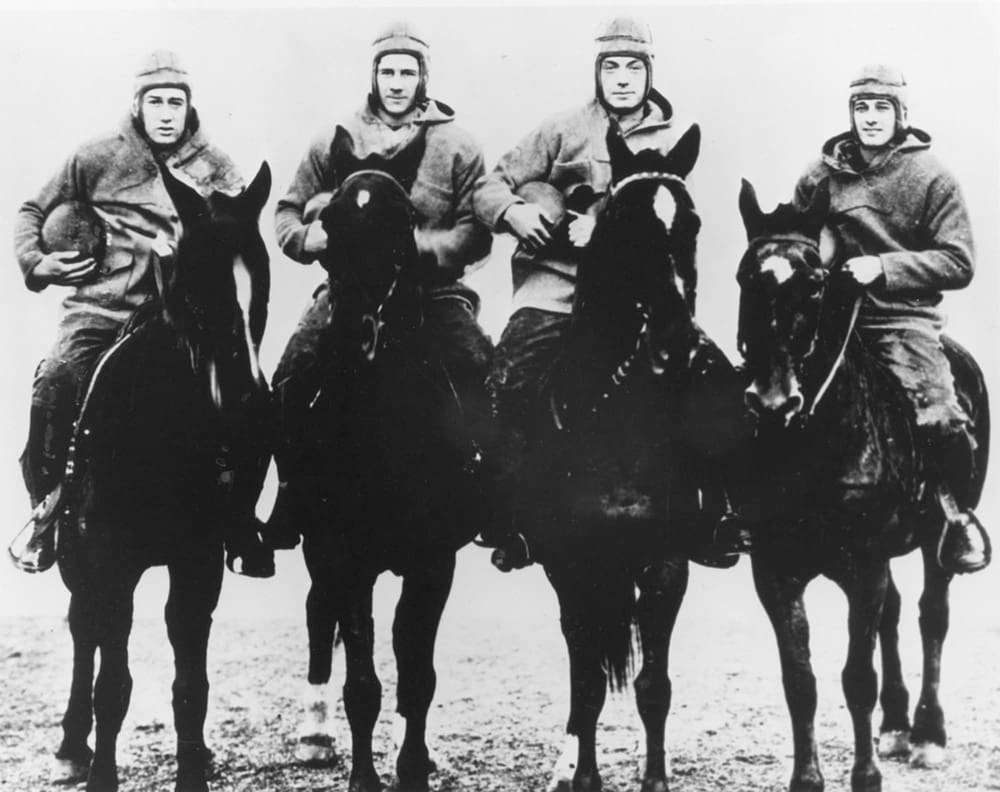
The "Four Horsemen" immortalized by Grantland Rice. Left to right- Don Miller, Elmer Layden, Jim Crowley, and Harry Stuhldreher
When the "Twentieth Century Limited" braked at the Grand Central terminal, the Colonels once again enjoyed the reception which had become part of their travels over the last several years. The press turned out in large numbers representing the many newspapers in the city. The New York alumni had arranged to have buses lined up to take the team and fans to the Waldorf-Astoria. After everyone got checked in and stowed their baggage in their rooms, the same buses took everyone on a tour of Manhattan. The Colonels, most from smaller cities, had been impressed with the buildings in Louisville, with the skyline of San Francisco when they came across the bay from Oakland, with the 496-foot Custom House Tower in Boston, but nothing could prepare them for the skyscrapers of Manhattan.
As the guide on the bus would point out different landmarks, there were necks craned trying to see the tops of the towering buildings. The Neo-Gothic, Woolworth Building in lower Manhattan had been finished in 1913 and topped off at 792 feet. F.W. Woolworth had paid the construction cost of $13,500,000 in cash, which was met with amazement by the Colonels.
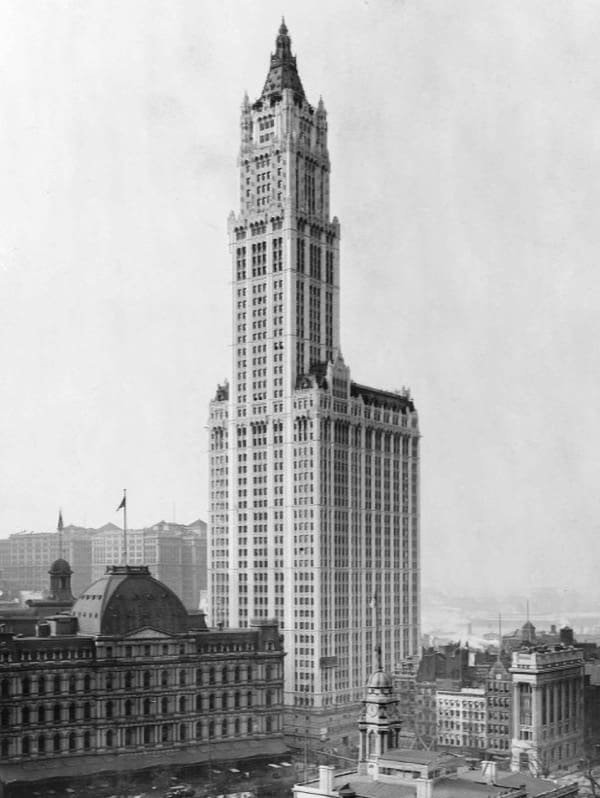
The Woolworth Building, at 792 feet, the tallest building in the world when the Colonels toured New York City
"Do you mean that he was able to build that with sales of 5 and 10 cent items?"
"All 58 stories?"
It was another world, hard to fathom. But it was part of the education of the Colonels as has been envisioned by the Chief from the start.
The tour was continued from the Woolworth Building to Battery Park where everyone got out and walked past Castle Clinton, a fort dating back to the War of 1812, to get a good view of the Statue of Liberty.
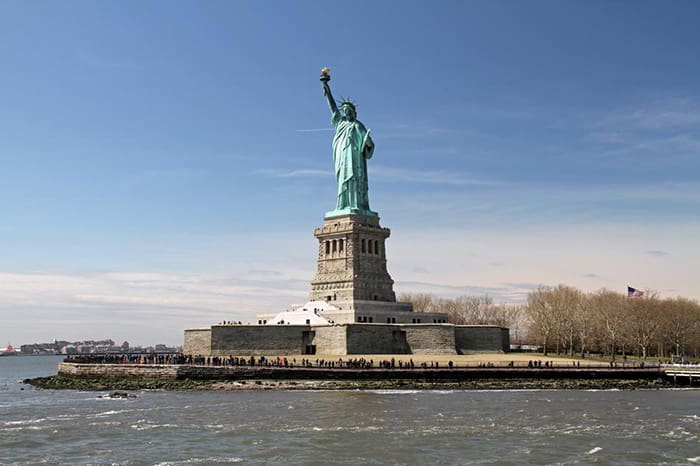
The Statue of Liberty, a must-see for the young men from Kentucky
As the guide was telling the story of the Statue, he began to recite the poem about your tired, poor, huddled masses yearning to be free and when he got to that line, one of the guys whispered, "Your hungry masses, wanting to eat free," which brought a chuckle from the players and an arched eyebrow from the Chief.
From Battery Park, it was over the Brooklyn Bridge, "Everybody has to go over the most famous bridge in the world," and a return back over the Manhattan Bridge for the long return to midtown and the Waldorf and lunch in the elegant dining room of the hotel.
You know, the Waldorf where we stayed in 1924 was the original hotel. It was as elegant as any place I'd ever stayed in. I actually had a small, single room. All of the players doubled up but somehow I got a room by myself. That's just the way it worked out. When Helen and I went back to a medical meeting after the war, in 1948, we also stayed at the Waldorf. But by this time, where we'd stayed with the team had been torn down and a new Waldorf had been built at another location. It was wonderful, but to tell you the truth, the old Waldorf seemed even finer than the new one, at least to me. Maybe it was because I was so awed by everything back then when I was younger.
Friday afternoon was spent in running through plays at the Polo Grounds. The stadium was as near to sacred ground as existed in baseball. Babe Ruth played there 3 years when the Yankees shared the Polo Grounds with the Giants and had established himself as the premiere long ball hitter in the game. Frankie Frisch had just finished his 6th season. Lefty O'Doul and Carl Mays had pitched off the mound which had been near the end of the field, as it was laid out for baseball. Everybody knew of the greatness of the New York Giants as the team had gone to the World Series 8 of the last 14 seasons.
There were photographers and reporters huddled around the Chief and Red Roberts, scribbling notes and taking pictures. Particular interest was paid to Red, as many of the reporters had covered the games in Harvard and were familiar with the big guy. Also, note was made that the only two who were at the upcoming West Virginia game and had also been in Charleston, West Virginia on November 8, 1919, were Red and the Chief.
Uncle Charlie had moved on. Dr. Ganfield was in Wisconsin. All of the rest who were there were gone.
One of the reporters asked Red if he could still get out on the field and "mix it up with younger guys."
Red took off his coat, tossed his cap onto the ground, got down in a crouch and lunged forward, picking the reporter up and holding him over his shoulder, smiling all the while. The reporter's hat fell off and he was kicking his feet up and down, hollering, "That's a 'yes,' isn't it Red? Now put me down. I'm going to say that's a 'yes!"'
Friday night was spent at a reception in the Waldorf which was hosted by Centre alumni and friends of the college.
Saturday morning found the Colonels getting ready for the game with West Virginia. The New York papers, in writing about the teams, painted a rosy picture about the boys from Morgantown, West Virginia, and printed the team's record from past years.
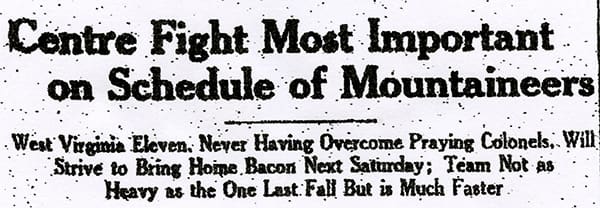
The Mountaineers were playing excellent football.
In 1922, they had gone 10-0-1, outscoring their opponents, 267-34, and won the East-West (Christmas) Bowl in San Diego, the same Bowl in which the Colonels defeated Arizona the previous year.
1922 WEST VIRGINIA ( 10-0-1)
West Virginia 20 West Virginia Wesleyan 3
West Virginia 55 Marietta 0
West Virginia 9 Pittsburgh 6
West Virginia 12 Washington and Lee 12
West Virginia 28 Rutgers 0
West Virginia 34 Cincinnati 0
West Virginia 33 Indiana 0
West Virginia 13 Virginia 0
West Virginia 28 Ohio University 0
West Virginia 14 Washington and Jefferson 0
East-West ( Christmas ) Bowl
West Virginia 21 Gonzaga 13
____________________________________________________________________________
The following year, the Mountaineers had a 7-1-1 record, and were just 7 points away from a perfect season.
1923 WEST VIRGINIA ( 7-1-1)
West Virginia 21 West Virginia Wesleyan 7
West Virginia 28 Allegheny 0
West Virginia 13 Pittsburgh 7
West Virginia 81 Marshall 0
West Virginia 13 Penn State 13
West Virginia 27 Rutgers 7
West Virginia 63 Washington and Lee 0
West Virginia 49 St. Louis University 0
West Virginia 2 Washington and Jefferson 7
The scoring average was bolstered by the game with W&L in which the Generals sent their 3rd team over to save their starters, and the thrashing of Marshall.
_________________________________________________________________________________________
In 1924, going into the Centre game in New York City, the team was 3-1.
1924 WEST VIRGINIA- ( 3-1)
West Virginia 21 West Virginia Wesleyan 6
West Virginia 35 Allegheny 6
West Virginia 7 Pittsburgh 14
West Virginia 55 Geneva 0
Centre was entering into a game with a team that was 20-2-2 over the past 3 seasons, allowing only 101 points in those 24 contests, and had shut out the opposition exactly half the time, having played 12 games where it hadn't allowed a score.
Centre had to be given credit for facing tough teams on its 5 trips to the East, meeting Harvard 3 times, Pennsylvania, and now an excellent West Virginia Mountaineers squad.
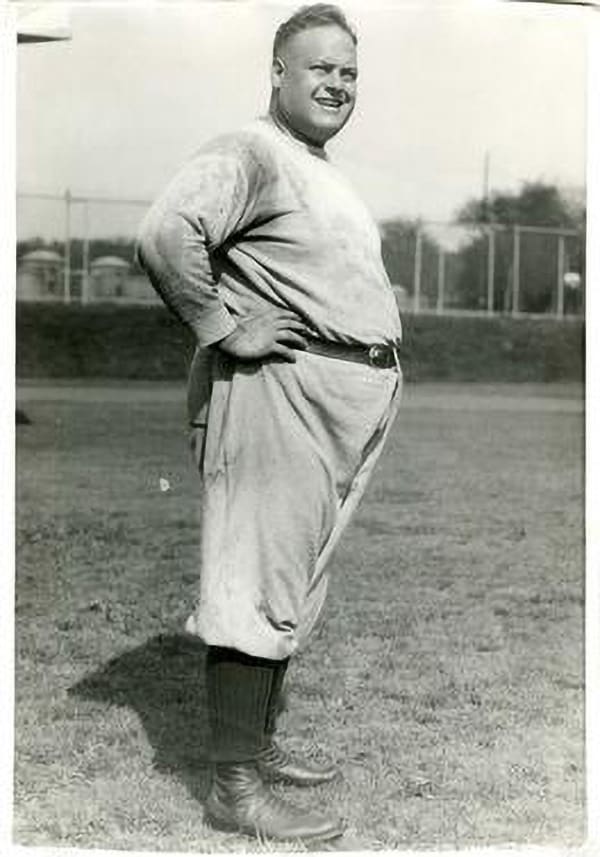
Coach Clarence Spears, who headed up the Mountaineers, had a sterling record of 20-2-2 during the past 3 seasons when Centre arrived in New York.
The crowd for the game wasn't what had been anticipated. There were several reasons. The Colonels had been tied by Valparaiso, and that took off some of the bloom. Also, people seemed to remember the score of the 1923 Penn game, and didn't realize that 24-0 didn't represent the true strengths of the Colonels and Quakers. Centre had played Penn evenly the 1st half, trailing only 3-0 due to a last minute, 2nd quarter field goal. Then, there was the fact that West Virginia had no following of significance in New York. If Columbia had been scheduled, or any of several nearby teams in the East, those schools would have brought their fans.
There also was the matter of Notre Dame, which had just beaten Army the week before at the Polo Grounds, and was now playing Princeton at Princeton while Centre and West Virginia squared off in New York. Many true followers of college football had chosen to travel to Princeton to see what the Irish could do with the Tigers. ( Notre Dame did quite well, winning 12-0 on its way to a 10-0 record, capped by beating Stanford in the Rose Bowl.)
And finally, perhaps most importantly, when Centre had been the little school which no one had heard of, and which continuously bumped off the bigger fellows, it was natural to turn out and to cheer on the underdog.
Centre's continued success over the years had removed the "novelty factor." It was a simple fact that over a period of time, an underdog which keeps winning loses that distinction.
The crowd was under 5,000, which in a 55,000 seat ballpark, looked pretty meager.
The game was an even match.

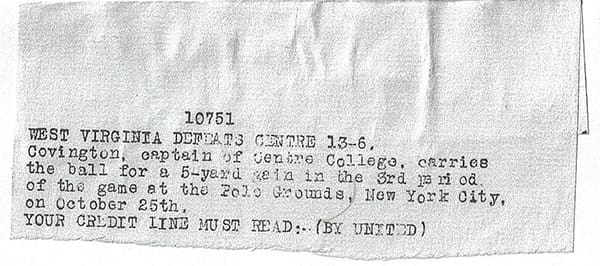
Caption of press photo of picture above taken during the 1924 Centre-West Virginia game with Herb Covington carrying the ball
Centre scored first when Hennie Lemon booted a 40 yard field goal from what was described as a "difficult angle." The 1st quarter ended, 3-0.
In the 2nd quarter, West Virginia scored on a double pass, missed the extra point, and it was 6-3 at the half.
Herb Covington kicked an 18 yard field goal in the 3rd period, and at the end of the quarter, it was 6-6.
It looked like the game was going to end as a tie. It had been a hard-hitting standoff, continuing that way as 10 minutes ticked off in the last quarter. However, as the clock wound down, the Mountaineers sent in a little 130 pound speedster named "Skeet" Farley who had fresh legs. "Skeet" began to make consistent gains against the weary Colonels who simply couldn't keep him from picking up yardage each time he was given the ball. Five times he got the signal. His 30 yards during the drive were the difference in the game, and West Virginia scored, got the extra point, and edged the Colonels, 13-6.


We just got worn down near the end of the game. We had two of our guys who were obviously injured pretty badly but continued to play. One thing different about the 1924 team from earlier years was that we just didn't have many real good substitutes. The 11 starters were as good as any of our teams. But after the starters, we didn't have much left as replacements.
The game was a draw statistically. The Colonels had a total yardage of 218 while West Virginia had 234. Centre only subbed twice, a pattern which was going to continue. The Mountaineers sent in 6 replacements.

2 substitutions for Centre
West Virginia finished the 1924 season at 8-1. In 1925, it was again 8-1, losing to Pittsburgh 15-7. For the seasons 1922-25, West Virginia had a record of 33-3-2, which makes the Centre close loss in 1924 understandable.
West Virginia was tough!
The Centre alumni had arranged for a night at the Ziegfeld Follies for the team after the game. They had purchased the tickets far in advance for $6.03 each. The headliner at the show was Will Rodgers, the famous humorist from Oklahoma.
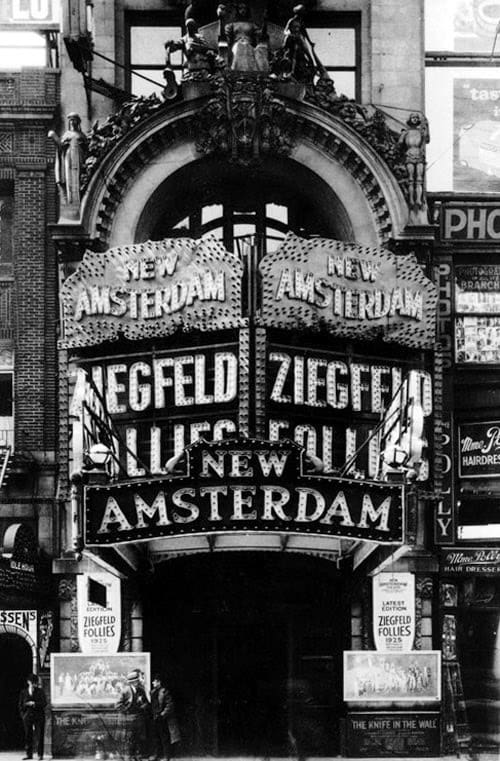
The New Amsterdam Theatre as it appeared during the 1924-25 run of the Ziegfeld Follies when Red Robertson and the team were there.
Going to the Ziegfeld Follies was a real experience for me. The show featured a lot of really attractive girls who did dance numbers which were like nothing I'd ever really seen.
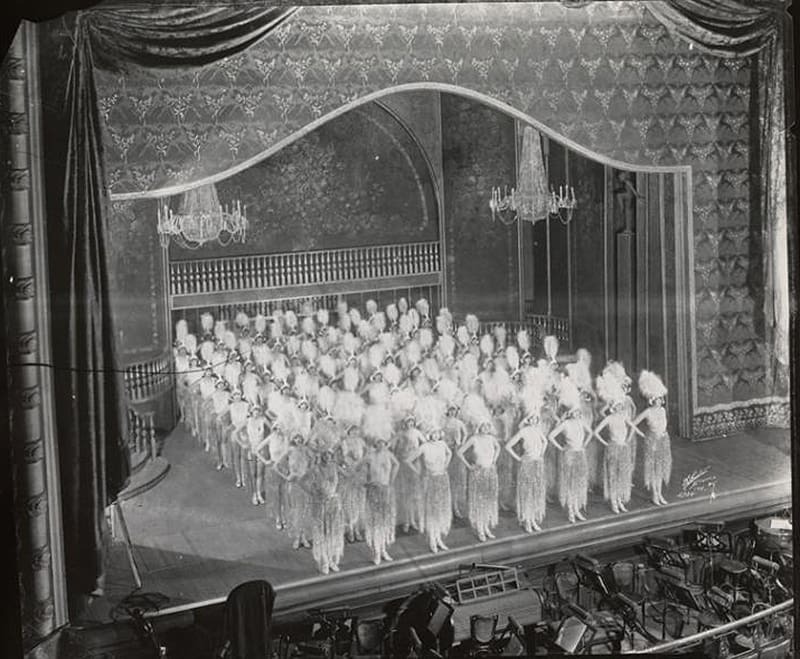
Photo from the 1924 Follies production
It was an event I'll never forget. It made such an impression on me that I saved my program from that night and have held onto it all of these years.

Red Robertson's program for the Ziegfeld Follies
Notre Dame had come to New York for the night after its game at Princeton and was also staying at the Waldorf and taking in the Follies. Will Rogers was the main attraction.

Will Rogers' credit highlighted. The production ran from June 24, 1924 until March 7, 1925
He paid a fine tribute to the guys from Notre Dame and asked Coach Rockne to get up and had his team stand, and then turned to Centre and did the same, introducing the Chief and then having our players stand also.
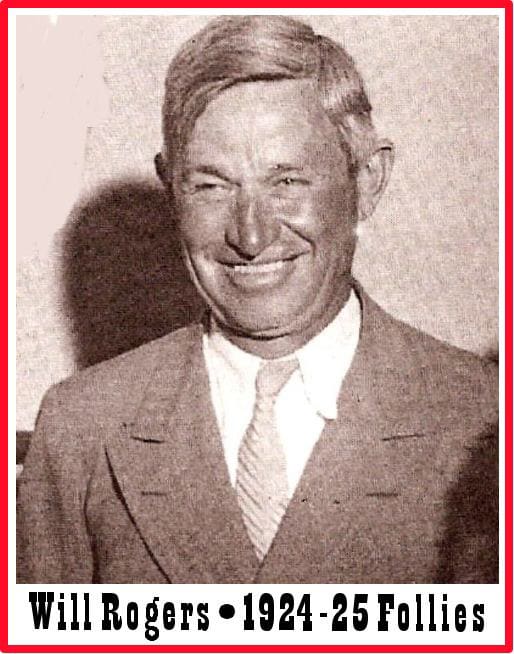
There was a capacity crowd which loved seeing the two famous teams and gave them both great cheers.
Will Rogers then made some comments and here's what he said as I can best remember.
"Notre Dame has it on Centre as far as substitutes. For many years, Centre had great baseball teams. That was when it had nine students enrolled in the college. A few years ago, two more students enrolled and Centre proceeded to win the football championship of the country. I want to make a plea that they don't invent any games with more than eleven players, for that would cut Centre out."
That produced a great laugh from the crowd because by this time, I suppose most everyone knew how small Centre was.
Rogers then wished both teams success and he was given a rousing cheer by both teams. Then both teams turned and gave a yell for each other.
A reporter was at the Follies.
It was a typical college affair, and the audience seemed to enjoy it as much as the gridders.
The team left on schedule the next morning at 8:45 and reached Danville at 11:35 the next morning. The trip home had taken just 10 minutes less than 27 hours.
There were over 400 people at the station to meet the team. Even in defeat, the boys who wore the Gold and White were idolized. After all, they were the Centre College Colonels, pride of the school, pride of Danville and Boyle County, and the pride of Kentucky.
Centre went out into the country carrying the banner. Win, lose or draw, they were Centre College.
Everybody wanted to know not only about the game but what I had thought about New York. I remember using the same word over and over, a word I don't think I'd ever used before.
It was simply, "dazzling! dazzling!"
